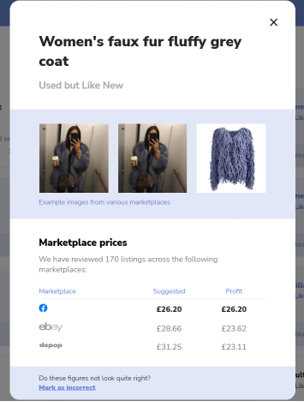
Selling second-hand thriftily
As we celebrate Earth Day, I thought there is no better chance than to share one of my favourite startups in the sustainability/ tech4good industry, and that is Thrift who aims to encourage people to buy and sell second hand items more, to result in less items wasted and ending up in landfill.
Mark O’Hara had always worked in retail management, but it wasn’t until he took on a big project to sell a sports nutrition product that he saw the significant barriers that limit businesses ability to sell items online effectively. Not only this, but also the inefficiencies in comparing, pricing and selling items across multiple marketplaces that made it so difficult, time consuming and expensive. It was here that the idea for Thrift came to him.
Having always thought he could do more with his skills, and wanting to do something to help the planet and be more sustainable in some way, he decided to go for it. He explained: “There had got to be an easier way for people to liquidate their assets in their home, but also help save money and recycle these products to help the circular economy.”
Unfortunately, Mark ended up in hospital with pneumonia and sepsis, and it was at this point in his life a few years after originally having the idea that he decided he really wanted to do something to contribute more and bring something worthwhile to the table. He explained: “I used my six-month recovery period to do some research, spoke to Lancaster University students, reached out to investors and crafted the concept in my mind.”
For Mark, this was just an opportunity to keep him busy whilst recovering, and whilst he thought it did have legs – he definitely didn’t think it would progress as much as it did. He added: “The concept is so much bigger and complicated than I first thought, and if I had known I don’t think I would have gone for it.”
Mark credits a lot of his success to Nova Growth Capital, as he received investment from them early on, but it wasn’t just the capital, he said: “A lot of it is down to Nova and the support they have given me. When things look big and daunting, we break things down into small chunks and it definitely makes things less scary.”
Mark said he had always been interested in algorithms, but never thought he could create a system that tells users what an item is worth on a second hand market, and that is exactly what he has done.

So what is Thrift?
Thrift is an online platform that helps users identify what their second-hand products will accurately be worth, and compare prices of recently sold items across all of the major selling platforms. Using Thrift people can contribute to more second hand items being sold online, and less items wasted ending up in landfill.
The second-hand market is definitely an increasing one, but Mark explained: “When you look at other search platforms in this area, you can really see how advanced Thrift is. We have created this platform to be a part of the circular economy, there still isn’t enough people selling on second hand markets, and we really need to change this.”
Thrift is designed not only to help people understand the price of their second hand items more, but also to encourage them to sell them on rather than just wasting. Mark added: “We fundamentally answer that all important question for people – is it even worth selling online? Which is definitely something that deters a lot of people in the first place.”
Once you know the item has value, it is encouraging more people to recycle. There are numerous market places out there you can sell on, but this isn’t all that is needed to encourage people to sell them, Mark explained the technology was needed to help people want to sell in the first place: “’How much is it worth?’ is one of the most common questions, and we can help tackle that with our system.”
The platform
Thrift is built with multiple algorithms for each market place, and accomplished with mass testing, which has taken place over the last few years. It works with two types of items, barcoded items which then leads to a bank of data online, and non-barcoded items which then rely on people’s visual input. Mark added: “These are only going to work with mass testing on people’s products and then scrutinising the result.”
People type in words that describe their product, then it will prioritise certain words and search and differentiate between different products and results, specifically for that item.
With the ability to analyse over one billion listings across three different marketplaces in under ten seconds, the platform is not only fast but also accurate as it provides true like-for-like product comparisons for even the most obscure, barcoded and non-barcoded items, and always prioritises actual sold data. It compares any items, not just clothes as most people think, and in any condition so you can really see if it worth selling your no-longer needed items.

Challenges
One of the hardest things as a founder is trying to slow down when you need to, and recognising when you need to. Mark said: “Often people want to rush ahead, when it is likely they are not ready.” Being a founder means putting your all into this idea and believing it can work, so sometimes people want to run before they can walk, which is understandable – but sometimes damaging.
Having a team around you that is comfortable and reliable is essential but getting to that stage with the right people is a challenge too Mark said.
Of course a challenge for all startups is funding, but Mark said he had a stroke of luck on his side when it came to raising. “I must be one of the luckiest founders, as I got funding off one of the first investment companies I approached. Looking back now obviously it is a stressful process as you don’t know what the outcome is going to be, and pitching itself is difficult.”
But for Mark the outcome was amazing, as the investors trusted what Mark was trying to achieve and he was able to prove to them he could do it. He added: “The further we go with Thrift the more advanced the technology is becoming, and that means we’re becoming more investable.”
Sustainability
“The whole point of starting Thrift was to do something that aligned more with who I am,” Mark explained. Thrift is a business contributing to sustainability, whilst also trying to be a sustainable business, and Mark explained this can be a challenge for a lot of founders; especially as lots of people claim to be green or sustainable, but in actual fact there is a lot of greenwashing on products, services and solutions that were just designed to scale.
He added: “The sustainability space is getting busier, and this is helping towards the circular economy. Competition is good, I personally speak to competitors, so much so that we even pivoted slightly so that we could protect ourselves from some of our competitors, it is just part of the process. It is an interesting area with huge possibilities, and huge potential for growth, and it is just going to get much more over crowded, so if anyone is worried about entering the sustainability market, just try and build something that adds value.”
One of the biggest issues when it comes to recycling and reusing items is people wanting to know the worth of them. Mark said at Thrift they are not just joining an already existing business, but are now building better infrastructure for the economy. “Our platform can now be used by all our competitors without the threat. The software can be added on to all the price research, this isn’t about us being another marketplace, that isn’t where I want to take it.”

The future
Mark explained the company is just coming to the end of some really interesting trials with British Heart Foundation: “We are just going through the data from these, which has been ongoing for the last four months.”
There are also a number of new customers, that Thrift will be turning on over the next few weeks, and the main area of focus will be starting its next development roadmap. Mark added: “The last year has been largely about testing the system in action against the hardest most obscure difficult weird and wacky items, you could possibly find in charity retail shops.”
From this, the team have completed a really good piece of work, and now know what the next version of Thrift needs to look like, and what changes need to be made. Mark assured me: “By March we will have a killer new platform. We literally have customers waiting to pay, but we cannot release it until we have all the development done.”
Finally, Mark wants to take this global. He added: “We want to start planning out the algorithms and development to build this in the US. We've got a couple of companies out there that are really interested in our platform and exclusivity of the technology, once it's ready to scale. There are a couple of companies who have tried over there but they have not cracked it, they are nowhere near as accurate.”

